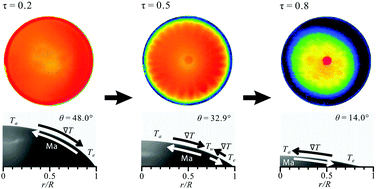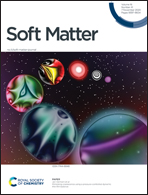Surface temperature transition of a controllable evaporating droplet†
Abstract
Surface temperature is a critical factor affecting the droplet evaporation; however, it is a continuous matter under discussion. We design controllable experiments for sessile ethanol droplet evaporation to investigate the surface temperature distribution evolution. It is found that the evaporation process of a droplet with a constant contact radius can involve five phases: non-wave phase, onset of thermal waves, decrease of thermal waves, transition phase, and final non-wave phase. Under fixed evaporation conditions and a fixed substrate temperature, the phase sequence is solely dependent on the instantaneous contact angle, but independent of the droplet initial volume. Three typical radial temperature distributions are observed at the evaporating droplet surface: a monotonic decrease from the edge to the apex; a nonmonotonic distribution with the highest temperature observed between the edge and the apex; or a monotonic increase from the edge to the apex. The three temperature distributions and the two transitions between them are responsible for the five phases in the evaporation process. However, the early phases may not exist in the sessile droplet with a relatively small initial contact angle. Both the evaporation pressure and the substrate temperature can affect the occurrence of the five phases in the evaporation process. It is noteworthy that the splitting and merging of thermal waves occur simultaneously during evaporation. During the decrease of the thermal waves phase, the number of waves decreases linearly with the contact angle tangent. The decreasing slope is influenced by the evaporation pressure and the substrate temperature.



 Please wait while we load your content...
Please wait while we load your content...